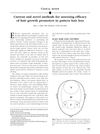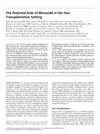Female pattern alopecia: current perspectives
August 2013
in “International Journal of Women's Health”

TLDR Female pattern hair loss is caused by multiple factors and while treatments like topical minoxidil, hormone therapy, and low-level light therapy can help, none can fully cure it.
The 2013 document "Female pattern alopecia: current perspectives" discussed female pattern hair loss (FPHL), a common condition characterized by reduced hair density, particularly on the crown and frontal scalp. The cause was believed to be multifactorial, involving genetic and hormonal factors. The only FDA-approved treatment at the time was topical minoxidil, but its effects were unpredictable and temporary. Other treatments included hormone therapy, hair transplantation, and off-label use of drugs like Finasteride and Dutasteride. Spironolactone showed promise, arresting hair loss progression in a study of 80 women. Low-level light therapy (LLLT) devices like the HairMax laser comb and The Oaze showed significant improvements in hair density and diameter. However, no treatment was curative, and the goal was to halt progression and improve remaining hair density.
View this study on dovepress.com →
Cited in this study

research Interventions for female pattern hair loss
Minoxidil effectively treats female pattern hair loss.

research Low-Level Light Therapy for Androgenetic Alopecia: A 24-Week, Randomized, Double-Blind, Sham Device–Controlled Multicenter Trial
Low-level light therapy safely improves hair growth and thickness for androgenetic alopecia.

research Mesotherapy using dutasteride-containing preparation in treatment of female pattern hair loss: photographic, morphometric and ultrustructural evaluation
Dutasteride-containing mesotherapy effectively treats female hair loss, improving density and thickness with minimal side effects.

research Iontophoresis-Targeted, Follicular Delivery of Minoxidil Sulfate for the Treatment of Alopecia
Iontophoresis improves minoxidil delivery for alopecia treatment.

research Combination therapy with finasteride and low-dose dutasteride in the treatment of androgenetic alopecia
Finasteride and low-dose dutasteride combo improves hair growth and reduces hair loss with no major side effects.

research Nutrition and Hair
Eating the right nutrients can improve hair health, but taking extra supplements usually doesn't help unless you have a deficiency.

research Hair regrowth in a male patient with extensive androgenetic alopecia on estrogen therapy
Estrogen therapy helped regrow hair in a bald man.
research Finasteride in the treatment of female pattern (androgenic) alopecia: a case report and review of the literature.

research 1α,25-Dihydroxyvitamin D3 Modulates the Hair-Inductive Capacity of Dermal Papilla Cells: Therapeutic Potential for Hair Regeneration
Vitamin D3 can help improve hair growth by enhancing the function of specific skin cells and could be useful in hair regeneration treatments.

research What women want - quantifying the perception of hair amount: an analysis of hair diameter and density changes with age in caucasian women
Caucasian women's hair appears thickest in their 20s, with perceived thinning after mid-30s due to both decreasing density and diameter.

research Association analysis of oestrogen receptor beta gene ( ESR2 ) polymorphisms with female pattern hair loss
ESR2 gene variations may be linked to female pattern hair loss.

research A randomized double-blind placebo-controlled pilot study to assess the efficacy of a 24-week topical treatment by latanoprost 0.1% on hair growth and pigmentation in healthy volunteers with androgenetic alopecia
Latanoprost 0.1% may effectively treat hair loss.

research Hormonal changes in menopause: do they contribute to a ‘midlife hair crisis’ in women?
Menopause-related hormonal changes affect hair but are not the only cause of hair changes in middle-aged women.

research A randomized, single-blind trial of 5% minoxidil foam once daily versus 2% minoxidil solution twice daily in the treatment of androgenetic alopecia in women
5% minoxidil foam once daily works as well as 2% minoxidil solution twice daily for female hair growth and is more convenient.

research Evidence-based (S3) guideline for the treatment of androgenetic alopecia in women and in men
Use minoxidil for hair loss; finasteride and dutasteride for men, dutasteride for women.
research Novel treatment of female-pattern androgenetic alopecia with injected bimatoprost 0.03% solution.

research Development and Characterization of Dutasteride Bearing Liposomal Systems for Topical Use
A new liposomal system for applying dutasteride to the skin was developed, showing better skin absorption and stability, potentially improving treatment for hair loss.

research Pilot Study of 15 Patients Receiving a New Treatment Regimen for Androgenic Alopecia: The Effects of Atopy on AGA
The new treatment regimen was effective in promoting significant hair growth in all 15 male patients with androgenic alopecia.

research Treatment of female pattern hair loss with the androgen receptor antagonist flutamide
Flutamide improves female hair loss when other treatments fail, but may cause liver toxicity.

research Role of genetics and sex steroid hormones in male androgenetic alopecia and female pattern hair loss: An update of what we now know
Genetics and hormones play a role in male and female hair loss, but more research is needed to fully understand it.

research Prospective Cohort Study on the Effects and Tolerability of Flutamide in Patients with Female Pattern Hair Loss
Flutamide effectively treats female pattern hair loss with low doses showing good liver tolerance.

research Use of spironolactone in dermatology.
Spironolactone is used in dermatology to treat skin conditions related to hormones, but is not safe for pregnant women or men.

research 5 mg/day finasteride treatment for normoandrogenic Asian women with female pattern hair loss
Finasteride improves hair density and thickness in women with hair loss.

research Iron deficiency in female pattern hair loss, chronic telogen effluvium, and control groups
Iron deficiency common in women, not always linked to hair loss; more research needed.

research Enhancing the Growth of Natural Eyelashes: The Mechanism of Bimatoprost-Induced Eyelash Growth
Bimatoprost is a safe and effective treatment for making eyelashes longer, thicker, and darker.

research Efficacy, safety, and tolerability of dutasteride 0.5 mg once daily in male patients with male pattern hair loss: A randomized, double-blind, placebo-controlled, phase III study
Dutasteride 0.5 mg daily improves hair growth safely in men with hair loss.

research Androgenetic alopecia in the paediatric population: a retrospective review of 57 patients
Alopecia common in teens, may indicate endocrine issue, minoxidil effective treatment.

research Innovative use of spironolactone as an antiandrogen in the treatment of female pattern hair loss.
Spironolactone helps regrow hair in women with hair loss.

research Controversy: is there a role for adjuvants in the management of male pattern hair loss?
Adjuvants, diet changes, and laser therapy may improve male pattern hair loss.

research Latanoprost in the treatment of eyelash alopecia in alopecia areata universalis
Latanoprost can effectively treat eyelash hair loss, with 45% of patients showing hair regrowth and no reported side effects.

research Hormonal therapy for acne: why not as first line therapy? facts and controversies
Hormonal treatments can help with acne but are not the first choice due to side effects and the need for careful patient selection.

research The efficacy of latanoprost in the treatment of alopecia areata of eyelashes and eyebrows
Latanoprost, a glaucoma treatment, was found ineffective in treating hair loss in eyebrows and eyelashes.

research Gene-wide association study between the aromatase gene (CYP19A1) and female pattern hair loss
Aromatase gene variation may increase female hair loss risk.

research Successful treatment of female-pattern hair loss with spironolactone in a 9-year-old girl
Spironolactone successfully treated hair loss in a 9-year-old girl.
research Alopecia Areata: Evidence-Based Treatments

research HairMax LaserComb® Laser Phototherapy Device in the Treatment of Male Androgenetic Alopecia
HairMax LaserComb® effectively promotes hair growth and stops hair loss in males with androgenetic alopecia, with no serious side effects.
research The use of low-level light for hair growth: Part I

research Androgen Dependence of Hirsutism, Acne, and Alopecia in Women
Hirsutism is more linked to high androgen levels than acne or hair loss, and a mix of hormonal tests is best for diagnosis; certain treatments can reduce symptoms.

research Medical treatments for male and female pattern hair loss
Minoxidil and finasteride treat hair loss in men, while minoxidil treats hair loss in women.

research Androgens and hair growth
Androgens can both increase and decrease hair growth in different parts of the body.

research Baldness, benign prostate hyperplasia, prostate cancer and androgen levels
The study found no link between baldness patterns and androgen levels in men with benign prostate enlargement or prostate cancer.

research A review of hormonal therapy for female pattern (androgenic) alopecia
Hormonal therapies like cyproterone acetate and spironolactone may help some women with hair loss, but finasteride 1mg is not useful, and the effectiveness of other treatments is still unclear.

research Topical fulvestrant solution has no effect on male and postmenopausal female androgenetic alopecia: results from two randomized, proof-of-concept studies
Fulvestrant solution doesn't help hair loss in men and postmenopausal women.

research Comparison of the efficacy and safety of topical minoxidil and topical alfatradiol in the treatment of androgenetic alopecia in women
Minoxidil works better for female hair loss than alfatradiol, both safe.

research Dutasteride improves male pattern hair loss in a randomized study in identical twins
Dutasteride helps slow hair loss and boosts hair growth.

research Treatment of female pattern hair loss with a combination of spironolactone and minoxidil
Spironolactone and minoxidil together effectively treat female pattern hair loss.

research Female pattern hair loss: current treatment concepts.
Minoxidil 2% and 5% are common treatments for female pattern hair loss, with other options including anti-androgens, oral contraceptives, and hair transplantation.

research The importance of dual 5α-reductase inhibition in the treatment of male pattern hair loss: Results of a randomized placebo-controlled study of dutasteride versus finasteride
Dutasteride more effective for hair growth, but has more side effects than finasteride.

research Follicular miniaturization in female pattern hair loss: clinicopathological correlations
Hair loss severity relates to increased miniaturization in female pattern hair loss.

research Effective treatment of female androgenic alopecia with dutasteride.
Dutasteride successfully treated a woman's hair loss when other treatments failed.

research Topical Application of Ketoconazole Stimulates Hair Growth in C3H/HeN Mice
Putting ketoconazole on the skin can help mice grow hair.

research Treatment of female pattern hair loss with oral antiandrogens
Oral antiandrogens effectively treat female hair loss, with better results in higher hair loss grades.

research Estrogens and the hair follicle. Ostrogene und der Haarfollikel
Estrogens generally inhibit hair growth and improve skin quality, but their exact effects on hair follicles are complex and not fully understood.

research Pharmacologic management of pattern hair loss
Treat pattern hair loss with finasteride and topical minoxidil.

research A randomized, placebo-controlled trial of 5% and 2% topical minoxidil solutions in the treatment of female pattern hair loss
5% and 2% minoxidil solutions effectively promote hair growth and reduce hair loss, with 5% being slightly more effective but having more side effects.

research Minoxidil: mechanisms of action on hair growth
Minoxidil boosts hair growth by opening potassium channels and increasing cell activity.
research Female Androgenetic Alopecia Treated by Finasteride: A Case Forward

research Finasteride Treatment of Patterned Hair Loss in Normoandrogenic Postmenopausal Women
Finasteride can slow hair loss and promote growth in postmenopausal women.

research Hair transplanting: an important but often forgotten treatment for female pattern hair loss
Hair transplanting is a useful, often overlooked treatment for female pattern hair loss.

research Scalp hair diameter increases during pregnancy
Pregnant women's hair gets thicker.
research Hair Regrowth and Increased Hair Tensile Strength Using the HairMax LaserComb for Low-Level Laser Therapy
The HairMax LaserComb made hair grow more and get stronger for people with hair loss.

research Androgenetic Alopecia in Women
Androgenetic alopecia in women needs more research and better management strategies.

research Use of cyproterone acetate, finasteride, and spironolactone to treat idiopathic hirsutism
All three treatments reduce hirsutism, but spironolactone works best long-term.

research Current and novel methods for assessing efficacy of hair growth promoters in pattern hair loss
New methods improve how we test hair growth treatments, but challenges like slow hair changes and high costs remain.

research Treatment of hyperandrogenic alopecia in women
Flutamide may slightly improve hair loss in women, but finasteride does not work.

research Hair loss in women with hyperandrogenism: Four cases responding to finasteride
Finasteride improves hair loss in women with hyperandrogenism.

research The Potential Role of Minoxidil in the Hair Transplantation Setting
Minoxidil helps stabilize hair loss, increase density, and reduce shedding after hair transplant surgery.

research Finasteride for female androgenetic alopecia
Finasteride increases hair density in female androgenetic alopecia, but individual results may vary.

research Comparative Efficacy of Various Treatment Regimens for Androgenetic Alopecia in Men
Best hair growth results from combining finasteride and minoxidil.

research Prostaglandin-Induced Hair Growth
Latanoprost can make eyelashes longer, thicker, and darker.

research Female pattern hair loss
FPHL is a common, age-related, genetic hair loss with unclear causes and limited treatment options.

research Effects of minoxidil 2% vs. cyproterone acetate treatment on female androgenetic alopecia: a controlled, 12-month randomized trial
Minoxidil works better for female hair loss, but cyproterone reduces scalp oiliness and causes menstrual issues.

research Effect of Latanoprost on Hair Growth in the Bald Scalp of the Stump-tailed Macacque: A Pilot Study
Latanoprost, a glaucoma drug, showed potential for promoting hair growth in bald monkeys, especially at higher doses.

research Female pattern hair loss
Hair loss in women is genetic, diagnosed by examination and biopsy, and treated with minoxidil, finasteride, or transplantation.

research Spironolactone‐induced hepatitis
A woman's liver problems improved after she stopped taking spironolactone.

research Androgenetic alopecia in men and women
Androgenetic alopecia involves genetics, hormones, and can be treated with medications or surgery.

research Hair density, hair diameter and the prevalence of female pattern hair loss
FPHL affects hair density and diameter, causing visible hair loss in older women.

research Incidence of Female Androgenetic Alopecia (Female Pattern Alopecia)
Hair loss in women is common, starts in late 20s, and affects 30% of women over 50.

research Lack of efficacy of finasteride in postmenopausal women with androgenetic alopecia
Finasteride doesn't effectively treat hair loss in postmenopausal women.

research Measuring Reversal of Hair Miniaturization in Androgenetic Alopecia by Follicular Counts in Horizontal Sections of Serial Scalp Biopsies: Results of Finasteride 1mg Treatment of Men and Postmenopausal Women
Finasteride 1mg helps reverse hair miniaturization in men and postmenopausal women.

research Changes in hair weight and hair count in men with androgenetic alopecia, after application of 5% and 2% topical minoxidil, placebo, or no treatment
Minoxidil increases hair weight and count temporarily in men with hair loss.

research Treatment of Hair Loss
Finasteride and minoxidil are effective for hair loss, but continued research is needed for better treatments.

research Finasteride in the treatment of men with frontal male pattern hair loss
Finasteride effectively treats frontal hair loss with few side effects.

research Finasteride in the treatment of men with androgenetic alopecia
Finasteride safely and effectively treats male pattern hair loss, but may cause reversible sexual issues and harm male fetuses.

research Association of Benign Prostatic Hyperplasia with Male Pattern Baldness
Men with enlarged prostates often have more severe baldness.

research Ketoconazole Shampoo: Effect of Long-Term Use in Androgenic Alopecia
Ketoconazole shampoo improves hair growth and reduces oil similarly to minoxidil in male pattern hair loss.

research Beneficial effect of spironolactone on androgenic alopecia
Spironolactone may help reduce hair loss in androgenic alopecia.

research Different Levels of 5α-Reductase Type I and II, Aromatase, and Androgen Receptor in Hair Follicles of Women and Men with Androgenetic Alopecia
People with hair loss have more androgen receptors and enzymes in certain follicles, with men and women showing different patterns.

research USE OF TOPICAL MINOXIDIL THERAPY FOR ANDROGENETIC ALOPECIA IN WOMEN
Minoxidil helps hair growth and reduces shedding in women.

research Psychological effects of androgenetic alopecia on women: Comparisons with balding men and with female control subjects
Hair loss affects women's mental health more than men's, causing anxiety, low self-esteem, and social insecurity.

research TREATMENT OF FEMALE ANDROGENETIC ALOPECIA WITH MINOXIDIL 2%
Minoxidil 2% effectively treats female hair loss, promoting growth and density.

research The importance of adequate serum ferritin levels during oral cyproterone acetate and ethinyl oestradiol treatment of diffuse androgen-dependent alopecia in women
Having enough iron improves the effectiveness of a specific hair loss treatment in women.

research Oral spironolactone therapy for female patients with acne, hirsutism or androgenic alopecia
Spironolactone is effective for treating acne, hirsutism, and androgenic alopecia in women with few side effects.

research Reversal of Baldness in Patient Receiving Minoxidil for Hypertension
Minoxidil helped bald patient regrow hair.

research Classification of the types of androgenetic alopecia (common baldness) occurring in the female sex
Common baldness, also known as Androgenetic Alopecia, is caused by a combination of genetic factors and hormones called androgens.
Related

research Efficacy of Topical Minoxidil and Oral Spironolactone Versus Minoxidil and Finasteride in Androgenic Alopecia
Both minoxidil-spironolactone and minoxidil-finasteride treatments work for hair loss, but minoxidil-spironolactone is slightly more effective, especially in women.
research The Progress of Common Treatments and Research for Androgenetic Alopecia

research 573 A review of the use of platelet rich plasma for the treatment of androgenic alopecia
Platelet Rich Plasma can potentially help in restoring hair loss, but more research with larger groups is needed to confirm its effectiveness and standardize its use.

research Hair Restoration in Androgenetic Alopecia: Looking Beyond Minoxidil, Finasteride and Hair Transplantation
Alternative treatments show promise for hair growth beyond traditional methods.

research Female pattern alopecia: current perspectives
Female pattern hair loss is caused by multiple factors and while treatments like topical minoxidil, hormone therapy, and low-level light therapy can help, none can fully cure it.

research Promising therapies for treating and/or preventing androgenic alopecia.
There are potential treatments for pattern baldness, but more research is needed to confirm their effectiveness.

research Treatment of female pattern hair loss with the androgen receptor antagonist flutamide
Flutamide improves female hair loss when other treatments fail, but may cause liver toxicity.

research Types of Hair Loss and Treatment Options, Including the Novel Low-Level Light Therapy and Its Proposed Mechanism
Hair loss treatments include medications and new methods like low-level light therapy, which may work by boosting cell activity and blood flow.

research Female pattern hair loss: current treatment concepts.
Minoxidil 2% and 5% are common treatments for female pattern hair loss, with other options including anti-androgens, oral contraceptives, and hair transplantation.
research A4. Hair loss – surgical and pharmacological treatment
Hair loss can be treated with medications like finasteride and surgical methods like hair transplants.